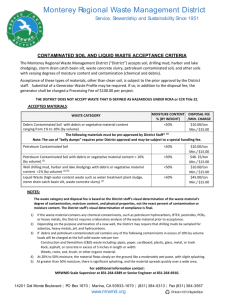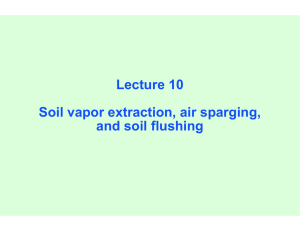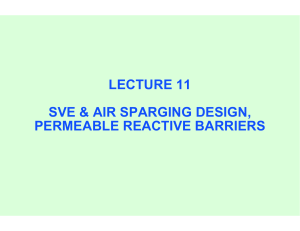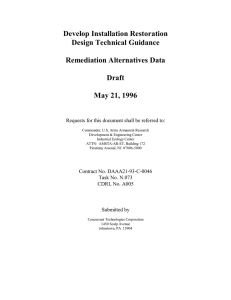Petroleum hydrocarbon originates from liquid fossil fuels called oil or
advertisement
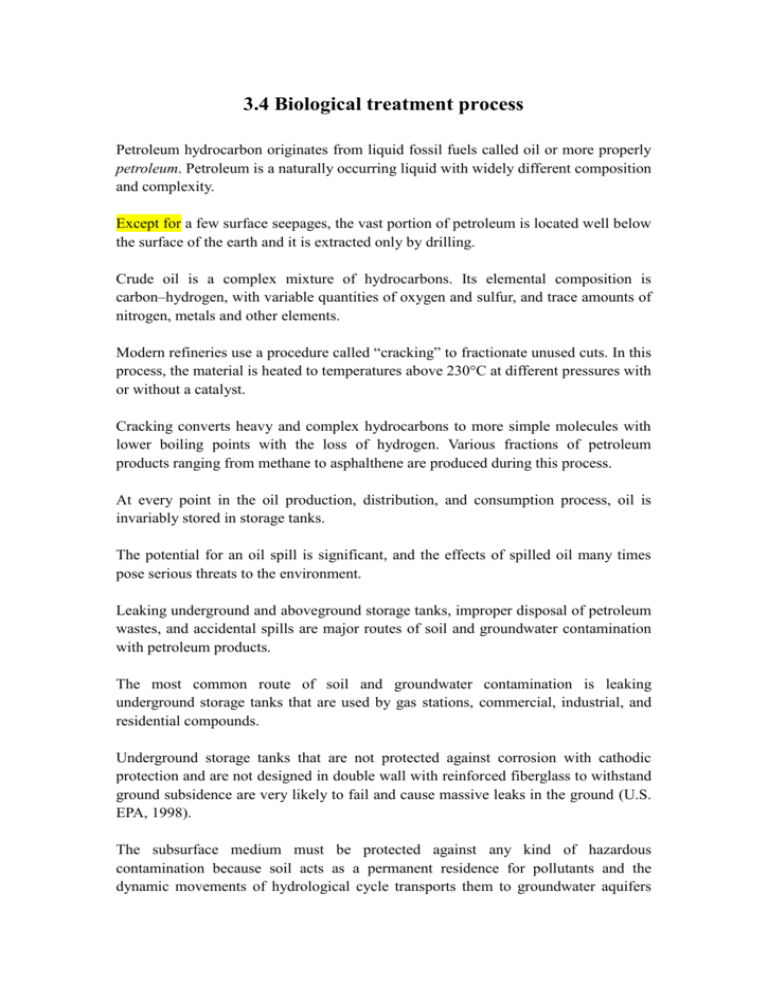
3.4 Biological treatment process Petroleum hydrocarbon originates from liquid fossil fuels called oil or more properly petroleum. Petroleum is a naturally occurring liquid with widely different composition and complexity. Except for a few surface seepages, the vast portion of petroleum is located well below the surface of the earth and it is extracted only by drilling. Crude oil is a complex mixture of hydrocarbons. Its elemental composition is carbon–hydrogen, with variable quantities of oxygen and sulfur, and trace amounts of nitrogen, metals and other elements. Modern refineries use a procedure called “cracking” to fractionate unused cuts. In this process, the material is heated to temperatures above 230°C at different pressures with or without a catalyst. Cracking converts heavy and complex hydrocarbons to more simple molecules with lower boiling points with the loss of hydrogen. Various fractions of petroleum products ranging from methane to asphalthene are produced during this process. At every point in the oil production, distribution, and consumption process, oil is invariably stored in storage tanks. The potential for an oil spill is significant, and the effects of spilled oil many times pose serious threats to the environment. Leaking underground and aboveground storage tanks, improper disposal of petroleum wastes, and accidental spills are major routes of soil and groundwater contamination with petroleum products. The most common route of soil and groundwater contamination is leaking underground storage tanks that are used by gas stations, commercial, industrial, and residential compounds. Underground storage tanks that are not protected against corrosion with cathodic protection and are not designed in double wall with reinforced fiberglass to withstand ground subsidence are very likely to fail and cause massive leaks in the ground (U.S. EPA, 1998). The subsurface medium must be protected against any kind of hazardous contamination because soil acts as a permanent residence for pollutants and the dynamic movements of hydrological cycle transports them to groundwater aquifers (Huling and Weaver, 1996). Once a liquid petroleum product is released into the ground it partitions into three separate phases: dissolved, liquid and gas. A small fraction of the petroleum hydrocarbon dissolves in the soil moisture or groundwater, a portion of the product remains in soil pore space in its pure liquid form as residual saturation and some of it evaporates into the air of soil pores. Pure phase liquids that do not readily dissolve in water are called non-aqueous phase liquids. Current clean-up techniques In situ soil vapor extraction Volatile and some semi-volatile organic compounds (VOCs and Semi-VOCs) can be removed from unsaturated soils by a process known as SVE. Chemicals that have boiling points lower than 220°C in an environment with one atmospheric pressure can be considered as volatile compounds (Fig. 1)(U.S. EPA, 1996). SVE brings fresh atmospheric air into contact with the contaminated subsurface by an induced vacuum. The continuous flow of air through the porous soil removes the NAPL, as well as the dissolved and the sorbed phases. SVE is an in situ clean-up process meaning that soils can be remediated without disturbance or excavation. SVE brings fresh atmospheric air into contact with the contaminated subsurface by an induced vacuum. The continuous flow of air through the porous soil removes the NAPL, as well as the dissolved and the sorbed phases into the moving air. When applied in the field, best results can be obtained if the subsoil stratum is uniform with high porosity and low moisture content and air streams follow a horizontal path. High concentrations of organic matter in soil can adsorb VOCs and may retard their volatilization process. Experimental results have shown that the NAPL phase is extracted from the contaminated soil in the early stages of vapor extraction Removal of the remaining portion of the compounds requires volatilization from the dissolved aqueous phase together with desorption from the solid surfaces into the dissolved aqueous phase (Nadim et al., 1997). In situ steam injection vapor extraction If the temperature of VOC and semi-VOCs increases, they can be stripped from soil at a much faster pace with vapor extraction wells. In situ steam extraction is a new technology and has had limited use in the United States. Steam extraction can be used in two different systems; mobile and stationary. The mobile system has a unit that volatilizes contaminants in small areas in a sequential manner by injecting steam and hot air through rotating cutter blades that pass through the contaminated medium. The stationary system uses steam injection as a means to volatilize and displace contaminants from the undisturbed subsurface soil. In both systems, steam (at 200°C) and compressed air (at 135°C) is forced through the soil medium and the mixture of air, vapor and chemicals are collected by extraction wells. In one pilot study, steam extraction alone was able to remove 90% of soil contamination Air sparging Air sparging is a method of site remediation that introduces air (or other gases) into the saturated zone contaminated with VOCs. In addition to volatilization of VOCs, air sparging promotes the growth of aerobic bacteria in saturated zones and may oxidize reduced chemical species. SVE wells are placed in sites where air sparging is applied and they extract the volatilized contaminants that are transported to the unsaturated zone by air sparging (Hoag et al., 1996). Hinchee (1994) categorizes air sparging as two distinct technologies, in-well aeration and the injection of air into the saturated zone. In-well aeration is the injection of air below the water table in a well, producing a physical change in the ground water system known as the “airlift pump effect”. As air bubbles move upward in the well and reach the water surface, they create a relative vacuum behind in their flow paths. This pressure difference causes the ground water to move into the well from the bottom screens and return to the aquifer from the shallower portion of the screens. This movement of ground water into the bottom of the well results in VOCs entering the well as they are stripped from solution with the sparging gas. A major draw back in this system is the gradual build up of bacteria and inorganic precipitation in the vicinity of the well screens that can significantly reduce the circulation of water and the sparging efficiency. The objective of the second air sparging technique is to inject pressurized air into the aquifer material through the well screens or diffusers. It has been reported that the injected air into the aquifer migrates in stable channels and only the contaminated soil within these channels are exposed to the injected air. If stable air channels form in the aquifer by air injection, the only removal process of the contaminants not in direct contact with the airflow paths would be liquid phase diffusion (Hoag et al., 1996). Equilibrium partitioning of the contaminants at the gas/water interface can be written as: Cg=CaqH, where Cg is the gaseous concentration in terms of milligram per liter, Caq is the aqueous concentration in milligram per liter, and H is the dimensionless Henry's law constant. This relation can be used to describe the partitioning of gas and water in the sparging system. The efficiency with which air sparging transfers oxygen to water is measured by determining the rate at which the dissolved oxygen concentration of ground water increases. Increase in oxygen concentration depends on the partial pressure of oxygen in the sparging gas, which in part depends on the gauge pressure of the air pump. In a study conducted by Hoag, 1996, a gauge pressure of 0.96 atm was required to induce air sparging, 8 m below the water table in an aquifer formation of silt and sand.





